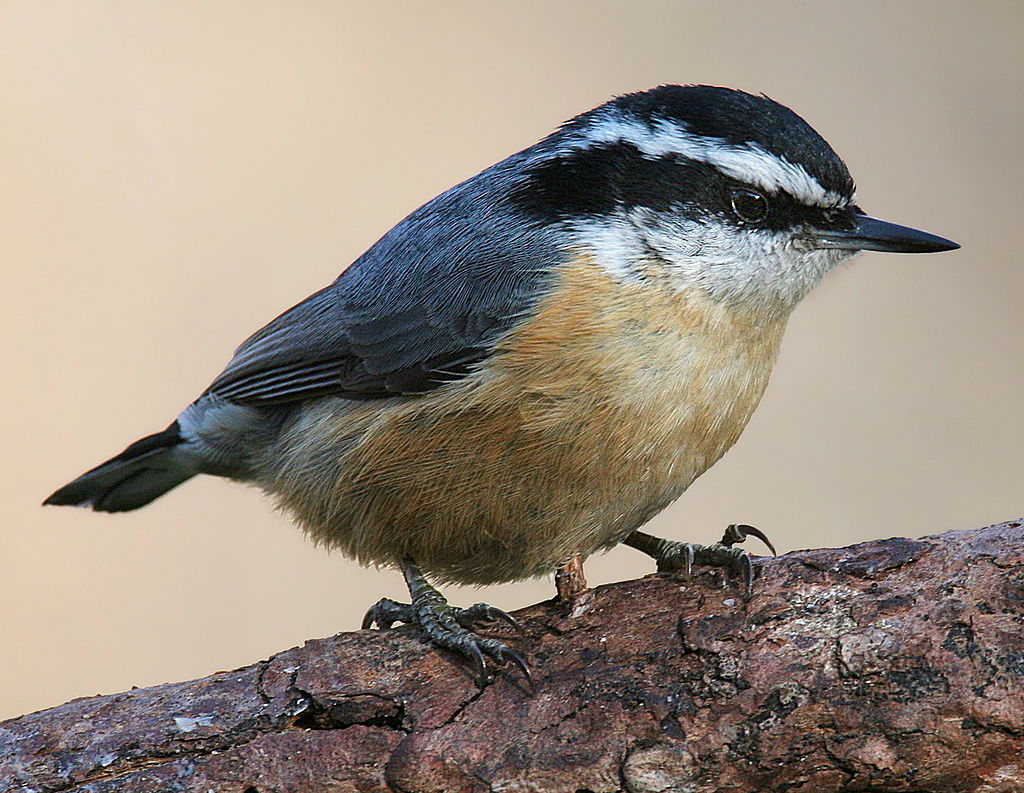Retirees who want to escape the cold and ice to spend the winter down south are known as “snowbirds.” Actually, this nickname describes the Dark-eyed Junco (Junco hyemalis). Juncos are arriving here now after spending the summer nesting in the mountains of New England and in the Canadian Boreal Forest. They will head back north next spring. In winter they feed on seeds of plants many of us consider “weeds,” including Chickweed (Stellaria media), Lambsquarters (Chenopodium album), and Wood Sorrel (Oxalis stricta). You will also see juncos at feeders. With their slate-gray backs and upper bellies, and white outer tail feathers that flash as they fly away, they are easy to spot.

The smallest bird of the winter woods, not much larger than a Ruby-throated Hummingbird (Archilochus colubris), is the Golden-crowned Kinglet (Regulus satrapa). This species spends the summer nesting in northern coniferous forests but lives in a variety of forest habitats here in winter. I’ve even seen it flitting among the oaks growing along New Haven streets. Being so small, it is in constant motion, continually foraging for wintering insects and their eggs among bark and branches to fuel its metabolism. It would starve if it could not find food for a few hours on a cold day. Listen for its call, a high-pitched “tseet-tseet-tseet,” as it feeds.

White-throated Sparrows (Zonotrichia albicollis) are arriving now. You can tell this bird from other sparrows by its black and white (sometimes tan) striped head and white throat. Look for them on the ground in woods and brushy edges. They can also be easily identified by their loud “chink” call. The White-throated Sparrow is one of the few birds that sings during the winter. Listen for its plaintive “Old-Sam-Peabody-Peabody” song. You will see both Dark-eyed Juncos and White-throated Sparrows on the ground under your bird feeders.

Some bird species that usually stay north in the winter will fly south during an irruption, a mass movement to another location that occurs periodically. An irruption is happening this year for some of these boreal migrants. Rather than being due to cold temperatures, this movement is actually tied to food availability. When the fruit and seeds of spruces, pines, mountain ash, and other trees are scarce in the north, some birds seek food elsewhere. The Winter Finch Forecast (maintained for decades by biologist Ron Pittaway, who recently passed the torch to Tyler Hoar) uses reports from foresters, researchers, naturalists, and other observers about the northern tree seed crop to predict which bird species will fly south or west.
Boreal migrants spotted at feeders here recently confirm this forecast: the Purple Finch (Haemorhous purpureus), Pine Siskin (Spinus pinus), and another migrant (not a finch), the Red-breasted Nuthatch (Sitta canadensis).
You can tell a male Purple Finch from the more common male House Finch (Haemorhous mexicanus) by the deeper color on the Purple Finch’s head and upper back—it looks as if it was dipped in raspberry juice. The male House Finch’s more reddish head color does not extend down its back. Purple Finches like to eat black oil seed at feeders.

Red-breasted Nuthatches travel in mixed flocks with Black-capped Chickadees (Poecile atricapillus), Downy Woodpeckers (Picoides pubescens), and Golden-crowned Kinglets. Unlike the larger, resident White-breasted Nuthatch (Sitta carolinensis), the Red-breasted Nuthatch has a reddish belly and black eye stripe. Its call is more nasal and higher pitched. Both species are called “upside-down birds,” as they often walk down a tree’s bark hunting for insects. They will take sunflower seeds, peanuts, and suet at feeders.

Pine Siskins are very gregarious and often travel and feed in flocks. This brown, streaked bird with yellow on the edges of its wings and tail is better identified by its harsh, ascending “zrweeet” call. If they are around, you will see them at thistle feeders.

Not every Blue Jay (Cyanocitta cristata) that you will see this winter is a permanent resident here. About a quarter of Blue Jays are migrants from northern climes. At this time of year, I often see them flying over highways as they migrate.

It’s a great time of year to observe these colorful visitors from the north. Put out a bird feeder or two and enjoy them.
Jim Sirch is an outstanding educator who communicates information so well to all age groups of readers. Thank you for your expertise!
LikeLiked by 1 person
Thx so much for your kind words Sam – you made my day!
LikeLike
Excellent, Jim. Many Thanks! Hope everyone’s well. Rick
LikeLike